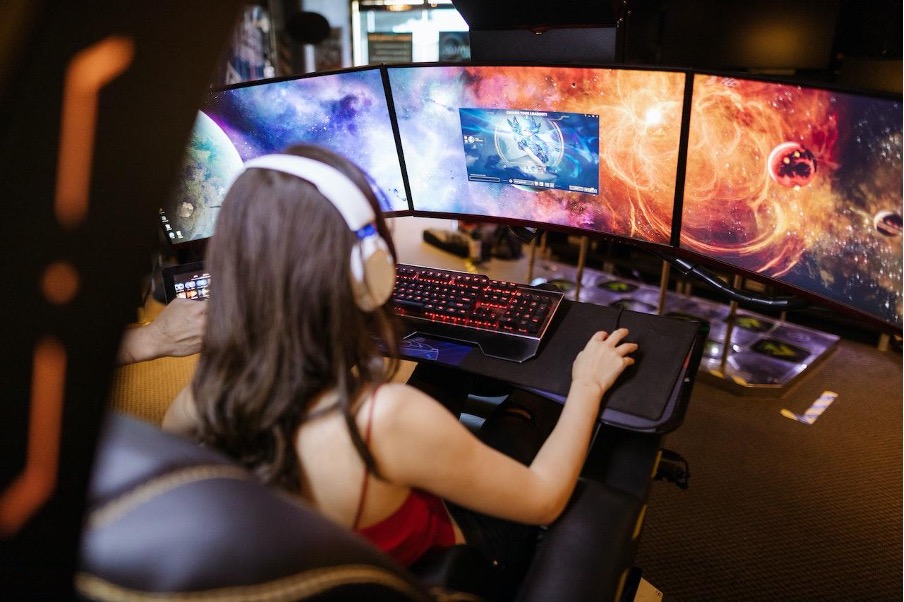Gaming on the Way to net-zero
Gaming on the Way to net-zero
We all love games! They have been pure entertainment since ancient times, drawing us into tricks, riddles and all kinds of challenges for the mind, body and spirit. Enter the Olympic Games. Today, they allow us to explore virtual worlds and do things that are impossible to do in real life. They give us the choice of being a warrior or a magician going on compelling quests to have fun times together with our friends, both online and physically. Even a casual game on our phone can help us deal with the stress of everyday life. They offer satisfaction through power-ups, level-ups, bonus features and coins as we make progress in the gameplay.

Games drive engagement and it is no surprise that many companies and educational institutions have started to implement the best secrets of gamification in their operations, products, and experiences. They are also becoming one of the best careers of the 21st century, with the overall global games market reaching 180-200 billion $USD worth in 2022. There are gamers and YouTubers who have managed to find a niche to earn millions just by playing games. Esports, game streaming and gaming tournaments can be one of the most lucrative sources of revenue nowadays. But there is a downside.
Gaming has a big Appetite for Energy
A typical gaming computer uses 1,400 kWh/year. This is six times more energy than a typical PC and 10 times more than a gaming console. The most intense system setups can use twice as much energy. Worldwide, in 2016 gaming computers consumed $10 billion worth of electricity (or 75 TWh) a year. While this is just 2.5 percent of total energy consumption by PCs around the world, it accounts for 20 percent of global computer energy use. This is the equivalent output of 25 standard electric power plants.
Some emerging technologies and activities are driving energy demand even higher. Cloud-based gaming, processor overclocking, higher-resolution connected displays broadcasting today’s mind-blowing graphics, sophisticated storylines and virtual reality gaming can each have this effect. Mining is another of the many factors that contribute to a product’s carbon footprint. Extraction of minerals, production, transportation, and factory output for gaming gear is pumping millions of tons of carbon dioxide into the atmosphere. The result is a widespread but poorly understood source of energy consumption.

Demand for cloud computing will only continue to grow and by 2025, worldwide annual data traffic will increase by 60% to 175 Zettabytes (175 trillion Gigabytes), with cloud computing applications driving the majority of this growth. The main climate impact of cloud computing lies in the vast amounts of electricity required to power the servers and keep them cool. Although gaming is currently only 7 percent of global network demand, with more than 95% of that being made up of downloading content, the possibility of streamed games could rapidly change this network footprint. One recent study estimated that if gamers moved to streaming over the next decade, carbon emissions could rise by 30 percent.
What is net-zero Gaming?
The energy use from this growing industry has gone unmeasured due to the lack of reliable energy data. This means both the gaming industry and the global audience of 3.07 billion gamers themselves are missing out on potential ways to save energy, lowering electric bills and greenhouse gas emissions in the process. The bottom line: Gaming provides almost half of humanity with a positive outlet, but it’s about time the industry levelled up its efforts towards net-zero gaming. At the GamesForest.Club, we propose looking at the challenge from the perspective of a global movement that -up to now- has been associated more with climate pollution than climate solution.
We have already seen significant interest and engagement within the gaming industry since the launch of the GamesForest.Club in November 2021, where all climate mitigation activities taking place in the real world are visualised in a digital twin forest. Companies are stepping up, opening their eyes to the problem in the real world and onboard a journey towards net-zero emissions. This involves several steps, some of which are summarised here:
Carbon accounting. You can solve a problem only if you can measure it. Companies quantify greenhouse gas emissions attached to their operations, supply chains and product development, so that they have an understanding of their climate impact. This offers the possibility to set concrete goals to limit their emissions.
Sustainable forms of travel. Hundreds of thousands of industry actors and gamers flock to almost 300 gaming events each year. By avoiding flying and choosing less polluting means of transportation like trains, reduces the burden on our warming planet.
Supporting carbon reduction projects. To reach their climate goals, companies support a variety of carbon projects by investing in forest protection initiatives that remove carbon dioxide from the atmosphere. These represent concrete climate action on the ground and are crucial in the fight against deforestation and biodiversity loss.
Although these areas do have an impact in addressing the carbon footprint of the gaming industry, they are themselves not enough. The prime goal for an industry in the era of climate action should be to reduce carbon emissions at source. In simple words, the fact that climate mitigation technology (such as creating a new forest) makes meaningful contributions to reducing corporate carbon footprints, should not give the green light to continue business-as-usual. Carbon offsetting should only be complementary to genuine commitments towards reducing carbon emissions in the first place, but also to promote a behavioural change.

Today, more than ever before, consumers expect carbon neutrality from businesses across all industries. Companies setting climate goals now can still have the chance to make net-zero business a strategic competitive advantage. Wait any longer, and the tightening regulation and timelines will decide the measures for them. Not to mention that investors increasingly request written climate and biodiversity strategies aligned to limiting a global temperature increase to 1.5 degrees, before they commit their money in any venture. Reaching that goal requires a lot of changes in strategy and operations and is in itself a challenge in today’s volatile environment. Luckily, gaming companies know best how to design massive challenges that encourage action that is not only impactful, but also fun. We welcome all competitors to join the race!